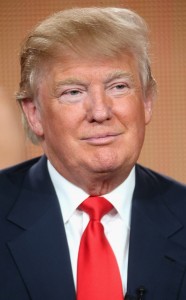
It’s a flag seen at many protests against presumptive Republican presidential nominee Donald Trump. It also can be spotted at immigration rallies, on murals in cities with sizeable Latino populations and at Mexican National team soccer games held on U.S. soil.
The flag of Mexico has a long history in the United States, despite being a symbol of a nation south of the border. It became a topic of discussion last week after a violent anti-Trump protest in Albuquerque.
Trump lashed out on Twitter after protests outside his Albuquerque rally sparked a riot that caused thousands of dollars in damage, condemning “thugs who were flying the Mexican flag.” His comments turned the emblem into a political symbol for those voicing their opposition to Trump’s controversial rhetoric against Mexicans and his insistence to build a wall between the two countries.
Within minutes, images of protesters waving the Mexican flag were shared on social media. Conservative radio talk show hosts repeatedly mentioned the flag as anti-Trump demonstrations moved to San Diego and Fresno, California.
Set to red, white and green bars, the Mexican flag contains in the center an eagle sitting on a cactus eating a snake. The central emblem is based on an indigenous legend of the Aztecs settling in present-day Mexico City on what was originally a lake-island.
After the United States took over a third of Mexico’s territory following the U.S-Mexican War in 1848, the flag remained a symbol of resistance due to broken promises outlined in Treaty of Guadalupe Hidalgo, said David Correia, an American Studies professor at the University of New Mexico. That treaty said former Mexican citizens from New Mexico to California would be granted full American citizenship, but instead, they faced illegal land seizures by whites and decades of discrimination, Correia said.
“In New Mexico, those claims have never been resolved,” said Correia.
In Houston and parts of Texas in the 1920s and 1930s, Mexican immigrants used the flag as symbols for their mutual-aid societies that provided funeral insurance and avenues for other civic engagement, said Lorenzo Cano, associate director for the Center of Mexican American Studies at the University of Houston.
“But they also flew it with the American flag,” Cano said.
That changed when returning World War II Mexican American veterans began getting involved in civil rights. G.I. Forum founder Dr. Hector P. Garcia and John J. Herrera, a national president of the civil rights group the League of United Latin American Citizens, discouraged the use of the Mexican flag and believed sporting the American flag at events and protests reinforced the notion that Americans of Mexican descent were the targets of racism.
During the Chicano Movement of the 1970s, a more militant movement like the black power movement, activists proudly brought the Mexican flag to protests to showcase their ethnic pride, Jennie Luna, a Chicana/o Studies professor at California State University Channel Islands, said. “It also reminded people that our history is one about being displaced,” Luna said.
Luna said today waving the Mexican flag is no different than Italian Americans waving the Italian flag in New York’s Little Italy or Irish-Americans carrying the Irish flag in South Boston. “The difference is that Mexican Americans have never been fully incorporated into the history of this country,” Luna said. “On top of that, the language Trump uses reinforces the idea that all Mexicans are foreigners.”
Karla Molinar, 21, a University of New Mexico student who was thrown out of the Trump rally in Albuquerque for disrupting his speech, said she saw nothing wrong with protesters waving the Mexican flag. “They are just showing that they are proud of where they came from and they won’t put up with the hate,” said Molinar, who was born in Mexico.
Trump’s latest tirade against Mexicans came only this week after U.S. District Judge Gonzalo Curiel, an American of Mexican origin, agreed to unseal the details in a class-action lawsuit by people who say they were victims of fraud by Trump’s real estate business education venture, the now-defunct Trump University.
Curiel has “an inherent conflict of interest” because Trump is “building a wall,” the billionaire real estate mogul said in an interview with The Wall Street Journal. He told CNN Friday that Curiel is “of Mexican heritage,” dismissing the fact that Curiel was born in Indiana, saying only: “He’s proud of his heritage.”
Orlando Baca, a retired teacher in Santa Fe, New Mexico and a Republican, said it would have been better if Latino anti-Trump protesters, especially immigrants, started waving the American flag to highlight their grievances.
“If things are so good for some back in Mexico and you are so proud of being Mexican, then why didn’t you just stay there?” said Baca, whose family’s presence in the United States goes back centuries. “If you are an American, be proud that you are an American. It’s about respect.”

No comments:
Post a Comment